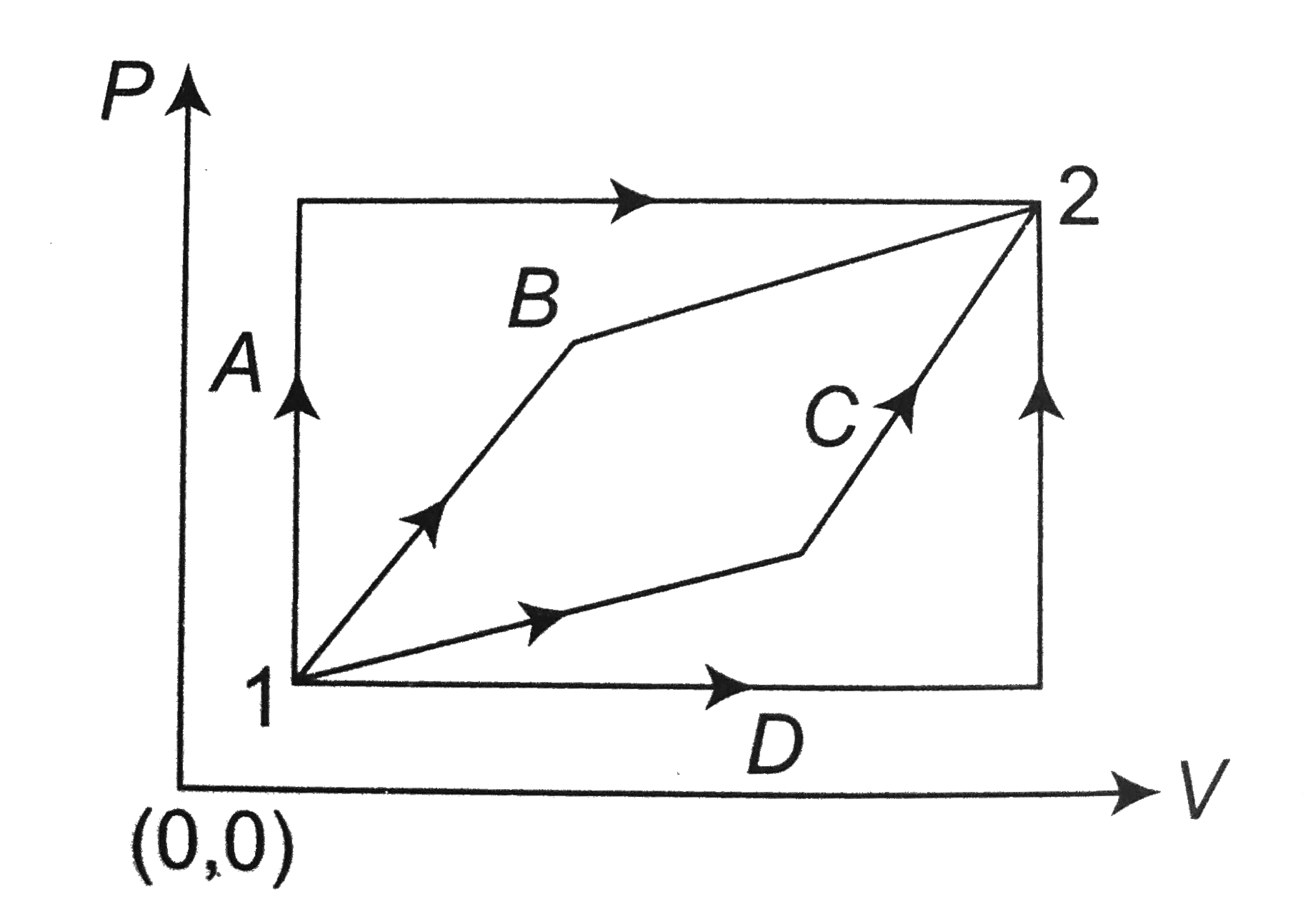An ideal gas can be taken form initial state 1 to final state 2 by two different process. Let ΔQ and W represent the heat given and work done by the system. Then which quantities is/are same in both process (where ΔU= internal energy of gas)
ΔQ
W
ΔU
ΔQ−W
The correct Answer is:C, D
To solve the problem, we need to analyze the properties of the quantities involved in the processes of an ideal gas transitioning from an initial state (1) to a final state (2) through two different paths. We will focus on the heat (ΔQ), work done (W), internal energy (ΔU), and the relationship between these quantities.
1. Understanding the Definitions:
- Internal Energy (ΔU): This is a state function that depends only on the initial and final states of the system, not on the path taken.
- Heat (ΔQ) and Work (W): Both are path functions, meaning their values depend on the specific process or path taken between the two states.
2. Identifying the State Function:
- Since ΔU is a state function, it will have the same value regardless of the path taken. Therefore, for both processes from state 1 to state 2, ΔU will be the same.
3. Applying the First Law of Thermodynamics:
- The First Law of Thermodynamics states that:
ΔU=ΔQ−W
- Since ΔU is the same for both processes, we can conclude that the difference between heat added (ΔQ) and work done (W) must also be the same for both processes.
4. Conclusion:
- The quantities that are the same for both processes are:
- The change in internal energy (ΔU)
- The expression ΔQ - W
Final Answer:
- The quantities that are the same in both processes are:
- ΔU (Change in internal energy)
- ΔQ - W (Difference between heat added and work done)
- Internal Energy (ΔU): This is a state function that depends only on the initial and final states of the system, not on the path taken.
- Heat (ΔQ) and Work (W): Both are path functions, meaning their values depend on the specific process or path taken between the two states.
- Since ΔU is a state function, it will have the same value regardless of the path taken. Therefore, for both processes from state 1 to state 2, ΔU will be the same.
- The First Law of Thermodynamics states that:
ΔU=ΔQ−W
- Since ΔU is the same for both processes, we can conclude that the difference between heat added (ΔQ) and work done (W) must also be the same for both processes.
- The quantities that are the same for both processes are:
- The change in internal energy (ΔU)
- The expression ΔQ - W
- The quantities that are the same in both processes are:
- ΔU (Change in internal energy)
- ΔQ - W (Difference between heat added and work done)
Topper's Solved these Questions
- KTG & THERMODYNAMICSBOOK - RESONANCE ENGLISHCHAPTER - KTG & THERMODYNAMICSEXERCISE - PART -IV
9 Videos
- KTG & THERMODYNAMICSBOOK - RESONANCE ENGLISHCHAPTER - KTG & THERMODYNAMICSEXERCISE - Exercise-3
1 Videos
- KTG & THERMODYNAMICSBOOK - RESONANCE ENGLISHCHAPTER - KTG & THERMODYNAMICSEXERCISE - PART -I
15 Videos
- KINETIC THEORY OF GASES AND THERMODYNAMICSBOOK - RESONANCE ENGLISHCHAPTER - KINETIC THEORY OF GASES AND THERMODYNAMICSEXERCISE - Exercise
64 Videos
- MAGNETIC FIELD AND FORCESBOOK - RESONANCE ENGLISHCHAPTER - MAGNETIC FIELD AND FORCESEXERCISE - Exercise
64 Videos
Similar Questions
A system can be taken from the initial state p1,V1 to the final state p2,V2 by two different methods, let ΔQandΔW represent the heat given to the system and the work done by the system. Which of the following must be the same in both the method?
View SolutionAn ideal gas can be expanded form an initial state to a certain volume through two different processes PV2= constant and (ii) P=KV2 where K is a positive constant. Then
View Solution
Knowledge Check
An ideal gas undergoes isothermal process from some initial state i to final state f. Choose the correct alternatives.
A1.dU=dQB2. dU=-dWC3. dU=0D4. dU=dW
An ideal gas can be expanded form an initial state to a certain volume through two different processes PV2= constant and (ii) P=KV2 where K is a positive constant. Then
View SolutionIf ΔU and ΔW represent the increase in internal energy and work done by the system resectively in a thermodynamical process, which of the following is true?
View SolutionAn ideal gas is taken from an initial state i to a final state f in such a way that the ratio of the pressure to the absolute temperature remains constant. What will be the work done by the gas ?
View SolutionStatement I: When an ideal gas is taken from a given thermodynamics state A to another given thermodynamic state B by any polytropic process, the change in the internal energy of the system will be the same in all processes.
Statement II: Internal energy of the ideal gas depends only upon its absolute temperature.
View SolutionLet Q and W denote the amount of heat given to an ideal gas the work done by it in an isothermal process.
View SolutionLet QandW denote the amount of heat given to an ideal gas and the work done by it in an adiabatic process.
View SolutionAn ideal gas is taken from state 1 to state 2 through optional path A,B,CandD as shown in the PV diagram. Let Q,WandU represent the heat supplied, work done and change in internal energy of the gas respectively.
Then,

View Solution
